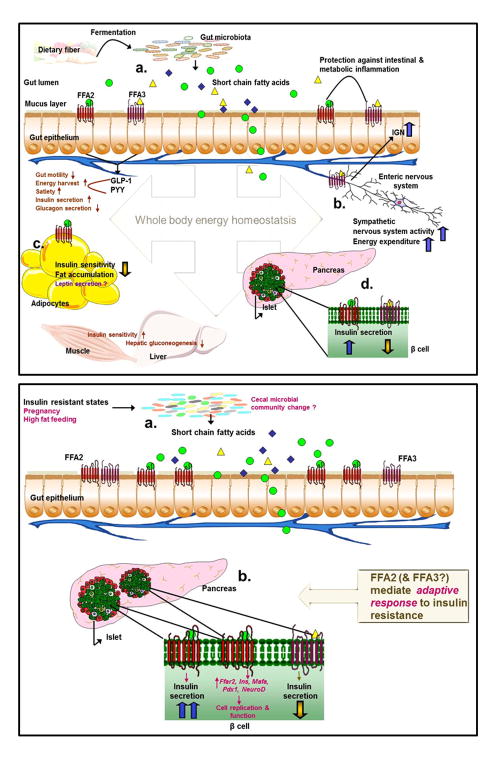Figure 2.
Homeostatic role of FFA2 and FFA3 in energy metabolism, a global view (upper panel) and β cell-specific view (lower panel).
Gut microbial fermentation products, SCFAs, activate FFA2 and -3 on enteroendocrine L cells stimulating the release of GLP-1 and PYY, which affect energy absorption and metabolism via effects on gut function and outside the gut (a). Activation of FFA3 on the enteric neurons and sympathetic ganglia enhances intestinal gluconeogenesis and sympathetic outflow, reducing hepatic glucose production and increasing energy expenditure (b). Stimulation of FFA2 decreases insulin signaling in adipocytes with a consequent increase in energy expenditure in other tissues (c). In β cells, activation of FFA2 or FFA3 causes opposing affects on insulin secretion (d). Lower panel: Under states of insulin resistance (pregnancy and high fat feeding), gut microbiota composition changes may lead to altered cecal and plasma levels of SCFAs (a). In β cells, increased expression and activation of FFA2 causes compensatory increase in insulin secretion and transcription of factors responsible for increased β cell proliferation and mass, contributing to adaptive responses of the β cell to insulin resistance. The role of FFA3 in insulin resistance is less clear (b).
Abbreviations: IGN, intestinal gluconeogenesis; Ins, insulin; Mafa, v-maf musculoaponeurotic fibrosarcoma oncogene family, protein A; NeuroD, neuronal differentiation 1; Pdx1, pancreatic and duodenal homeobox 1; PYY, peptide YY; SCFAs, short chain fatty acids. Green circles= acetate; yellow triangles= propionate; blue diamonds= butyrate. Dark brown: effects secondary to receptor activation; purple: unclear roles of receptor signaling; magenta: insulin resistance mediated changes.

